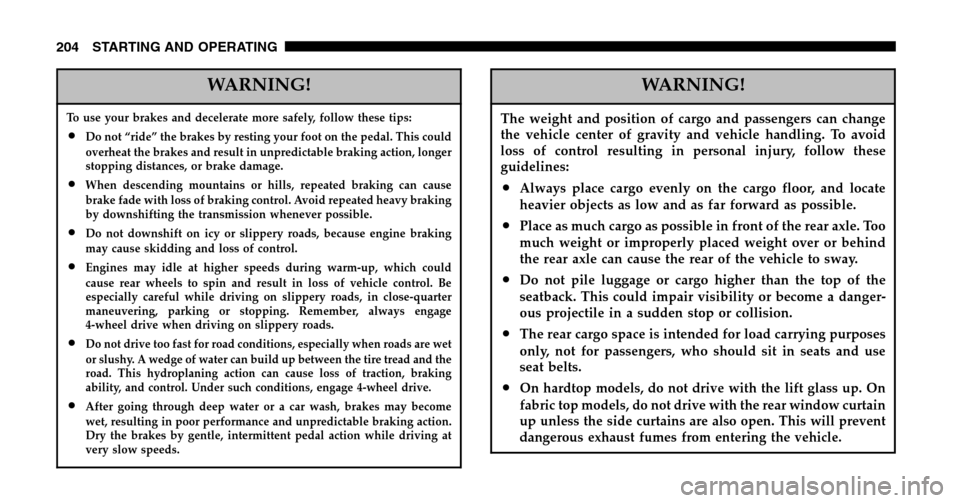Front brakes JEEP WRANGLER 2006 TJ / 2.G Owners Manual
[x] Cancel search | Manufacturer: JEEP, Model Year: 2006, Model line: WRANGLER, Model: JEEP WRANGLER 2006 TJ / 2.GPages: 368, PDF Size: 14.3 MB
Page 204 of 368

WARNING!
To use your brakes and decelerate more safely, follow these tips:
•Do not “ride” the brakes by resting your foot on the pedal. This could
overheat the brakes and result in unpredictable braking action, longer
stopping distances, or brake damage.
•When descending mountains or hills, repeated braking can cause
brake fade with loss of braking control. Avoid repeated heavy braking
by downshifting the transmission whenever possible.
•Do not downshift on icy or slippery roads, because engine braking
may cause skidding and loss of control.
•Engines may idle at higher speeds during warm-up, which could
cause rear wheels to spin and result in loss of vehicle control. Be
especially careful while driving on slippery roads, in close-quarter
maneuvering, parking or stopping. Remember, always engage
4-wheel drive when driving on slippery roads.
•Do not drive too fast for road conditions, especially when roads are wet
or slushy. A wedge of water can build up between the tire tread and the
road. This hydroplaning action can cause loss of traction, braking
ability, and control. Under such conditions, engage 4-wheel drive.
•After going through deep water or a car wash, brakes may become
wet, resulting in poor performance and unpredictable braking action.
Dry the brakes by gentle, intermittent pedal action while driving at
very slow speeds.
WARNING!
The weight and position of cargo and passengers can change
the vehicle center of gravity and vehicle handling. To avoid
loss of control resulting in personal injury, follow these
guidelines:
•Always place cargo evenly on the cargo floor, and locate
heavier objects as low and as far forward as possible.
•Place as much cargo as possible in front of the rear axle. Too
much weight or improperly placed weight over or behind
the rear axle can cause the rear of the vehicle to sway.
•Do not pile luggage or cargo higher than the top of the
seatback. This could impair visibility or become a danger-
ous projectile in a sudden stop or collision.
•The rear cargo space is intended for load carrying purposes
only, not for passengers, who should sit in seats and use
seat belts.
•On hardtop models, do not drive with the lift glass up. On
fabric top models, do not drive with the rear window curtain
up unless the side curtains are also open. This will prevent
dangerous exhaust fumes from entering the vehicle.
204 STARTING AND OPERATING
Page 211 of 368

If you stall or begin to lose headwaywhile climbing a
steep hill, allow your vehicle to come to a stop and
immediately apply the brakes. Restart the engine and
shift to R (Reverse). Back slowly down the hill allowing
the compression braking of the engine to help regulate
your speed. If the brakes are required to control vehicle
speed, apply them lightly and avoid locking or skidding
the tires.
WARNING!
If the engine stalls or you lose headway or cannot
make it to the top of a steep hill or grade, never
attempt to turn around. To do so may result in
tipping and rolling the vehicle. Always back care-
fully straight down a hill in R (Reverse) gear. Never
back down a hill in N (Neutral) using only the brake.
Remember, never drive diagonally across a hill-always
drive straight up or down.
If the wheels start to slip as you approach the crest of a
hill, ease off the accelerator and maintain headway by
turning the front wheels slowly left and right. This may
provide a fresh “bite” into the surface and will usually
provide traction to complete the climb.
Traction Downhill
Shift the transmission into a low gear and the transfer
case to 4L (Low) range. Let the vehicle go slowly down
the hill with all four wheels turning against engine
compression drag. This will permit you to control the
vehicle speed and direction.
When descending mountains or hills, repeated braking
can cause brake fade with loss of braking control. Avoid
repeated heavy braking by downshifting the transmis-
sion whenever possible.
STARTING AND OPERATING 211
5
Page 245 of 368

CAUTION!
If the trailer weighs more than 1,000 lbs (454 kg)
loaded, it should have its own brakes and they
should be of adequate capacity. Failure to do this
could lead to accelerated brake lining wear, higher
brake pedal effort, and longer stopping distances.
WARNING!
Do not connect trailer brakes to your vehicle’s hy-
draulic brake lines. It can overload your brake sys-
tem and cause it to fail. You might not have brakes
when you need them and could have an accident.
Towing any trailer will increase your stopping dis-
tance. When towing you should allow for additional
space between your vehicle and the vehicle in front
of you. Failure to do so could result in an accident.
Towing Requirements — Trailer Lights & Wiring
Whenever you pull a trailer, regardless of the trailer size,
stop lights and turn signals on the trailer are required for
motoring safety.
The Trailer Tow Package may includ ea4and7pin
wiring harness. Use a factory approved trailer harness
and connector.
STARTING AND OPERATING 245
5